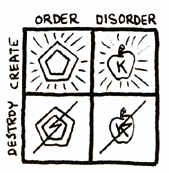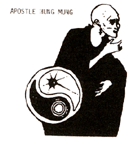RAW on Artistic Revolutionaries
Yo! Robert Anton Wilson has some inspired comments about art & artists. I paste an essay from his website below:
30 Apollo 78 p.s.U.
"There are only two kinds of artists: the plagiarists and the revolutionaries."
-- Paul Gauguin
I love this quote because it sums up my own philosophy of art so neatly.
To say it in my own jargon, Gauguin's "plagiarists" consist of those who do relatively good or relatively bad work within "the style of the period"-- the dominant paradigm or current reality-tunnel-- and the "revolutionaries" create an entirely new style, i.e a new reality-tunnel (or, in the case of Picasso, a new reality-labyrinth.)
These "plagiarists" (remember: this pejorative term comes from Gauguin, not from me) may provide light entertainment but they have low information in the sense of Shannon's "Mathematical Theory of Communication." (where information = the negative of the probability that you can predict the "signal" in advance. If you can always predict it, it ain't information.)
In general, dogma always produces low information; see, the Fundamentalists (Xtian, Judaic, Moslem etc.), Marxists, Objectivists, Aryan Nation, CSICOP etc.) You always know what such True Believers will say even before they say it, and they all say it in the same words as their Fuhrer. In art, the "style of the period" = an equivalent of (perceptual/conceptual.) dogma, a rigid and familiar reality-tunnel This kind of art reaches a large public immediately, because the mass consists mostly of (in Houseman's phrase) "fellows whom it hurts to think." People in general love the familiar and predictable and have "crawly" sensations at the unfamiliar and unpredictable.
The "revolutionaries" contain high information and a whole new "style" of reality-tunnel (high unpredictability) and annoy or infuriate the general public. Later, with time, they get consigned to "starters of crazes" or elevated to Masters (those who really did enrich our experience of Universe.)
In my opinion, the primary "revolutionary" Masters of our past century include Picasso, Klee, Pound, Joyce, Faukner Ginsberg, Frank Lloyd Wright, D.W. Griffith, Chaplin, Welles, Clint Eastwood,, Stravinsky, Gershwin, Epstein, Brancusi, Carlin : the man or woman who doesn't know their work deeply and richly still lives in the 19th Century as the rest of us prepare to enter the 21st. The artists on that list haven't become familiar enough to stop surprising us. We still need to interpret our interpreters, as Ellman said of Joyce.
The "plagiarists" appear on popular magazine covers and the NY Times best-seller lists. God bless them, they live happily and sincerely in the same world as the mass audience.
"There are only two kinds of artists: the plagiarists and the revolutionaries."
-- Paul Gauguin
I love this quote because it sums up my own philosophy of art so neatly.
To say it in my own jargon, Gauguin's "plagiarists" consist of those who do relatively good or relatively bad work within "the style of the period"-- the dominant paradigm or current reality-tunnel-- and the "revolutionaries" create an entirely new style, i.e a new reality-tunnel (or, in the case of Picasso, a new reality-labyrinth.)
These "plagiarists" (remember: this pejorative term comes from Gauguin, not from me) may provide light entertainment but they have low information in the sense of Shannon's "Mathematical Theory of Communication." (where information = the negative of the probability that you can predict the "signal" in advance. If you can always predict it, it ain't information.)
In general, dogma always produces low information; see, the Fundamentalists (Xtian, Judaic, Moslem etc.), Marxists, Objectivists, Aryan Nation, CSICOP etc.) You always know what such True Believers will say even before they say it, and they all say it in the same words as their Fuhrer. In art, the "style of the period" = an equivalent of (perceptual/conceptual.) dogma, a rigid and familiar reality-tunnel This kind of art reaches a large public immediately, because the mass consists mostly of (in Houseman's phrase) "fellows whom it hurts to think." People in general love the familiar and predictable and have "crawly" sensations at the unfamiliar and unpredictable.
The "revolutionaries" contain high information and a whole new "style" of reality-tunnel (high unpredictability) and annoy or infuriate the general public. Later, with time, they get consigned to "starters of crazes" or elevated to Masters (those who really did enrich our experience of Universe.)
In my opinion, the primary "revolutionary" Masters of our past century include Picasso, Klee, Pound, Joyce, Faukner Ginsberg, Frank Lloyd Wright, D.W. Griffith, Chaplin, Welles, Clint Eastwood,, Stravinsky, Gershwin, Epstein, Brancusi, Carlin : the man or woman who doesn't know their work deeply and richly still lives in the 19th Century as the rest of us prepare to enter the 21st. The artists on that list haven't become familiar enough to stop surprising us. We still need to interpret our interpreters, as Ellman said of Joyce.
The "plagiarists" appear on popular magazine covers and the NY Times best-seller lists. God bless them, they live happily and sincerely in the same world as the mass audience.
More RAW essays here.





No comments:
Post a Comment